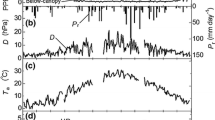Abstract
Seasonal patterns of photosynthesis and respiration of single leaves of four understory perennial herbs in deciduous forests were investigated in relation to their leaf growth and light conditions on the forest floor.Anemone flaccida shows rapid growth of leaf area and high rates of gross photosynthesis at light saturation (Psat) in its early stage of development. Its photosynthetic activity is restricted to a brief period of high light intensity before the closure of overstory canopies.Disporum smilacinum possesses light-photosynthesis curves of the shade-leaf type throughout its whole growing period. A shading experiment has shown that this plant is low-light adapted and can utilize weak light efficiently. The light-photosynthesis curve ofSyneilesis palmata shifts from the sun-leaf type to the shade-leaf type in response to the seasonal change of light regime on the forest floor. Evergreen leaves ofPyrola japonica have three year longevity, and light-photosynthesis curves of the shade-leaf type. They maintain some photosynthetic activity even in late autumn and winter.
Similar content being viewed by others

References
Anderson, M.C. 1964. Studies of the woodland light climate. II. Seasonal variation in the light climate. J. Ecol.52: 643–663.
Chabot, B.F. 1978. Environmental influences on photosynthesis and growth inFragaria vesca. New Phytol.80: 87–98.
Horikawa, Y. 1972. Atlas of the Japanese flora. Gakken, Tokyo.
Koyama, H. andS. Kawano. 1973. Biosystematic studies onMaianthemum (Liliaceae-Polygonatae). VII. Photosynthetic behaviour ofM. dilatatum under changing temperate woodland environments and its biological implications. Bot. Mag. Tokyo86: 89–101.
Lundegardh, H. 1921. Ecological studies in the assimilation of certain forest plants and shore plants. Svensk. Bot. Tidskr.15: 46–95.
Nobel, P.S., L.J. Zaragoza andW.K. Smith. 1975. Relation between mesophyll surface area, photosynthetic rate, and illumination level during development for leaves ofPlectranthus parviflorus Henckel. Plant Physiol.55: 1067–1070.
Numata, M. andS. Asano. 1970. Biological Flora of Japan Vol. 2, Sympetalae-2. Tsukiji shokan. Tokyo (in Japanese).
Ohwi, J. 1965. Flora of Japan. Smithsonian Inst., Washington.
Sparling, J.H. 1964. Ontario's woodland flora. Ontario Natur.2: 18–25.
— 1967. Assimilation rates of some woodland herbs in Ontario. Bot. Gaz.128: 160–168.
Taylor, R.J. andR.W. Pearcy. 1976. Seasonal patterns of the CO2 exchange characteristics of understory plants from a deciduous forest. Can. J. Bot.54: 1094–1103.
Young, D.R. andW.K. Smith. 1980. Influence of sunlight on photosynthesis, water relations, and leaf structure in the understory speciesArnica cordifolia. Ecology61: 1380–1390.
Author information
Authors and Affiliations
Rights and permissions
About this article
Cite this article
Koizumi, H., Oshima, Y. Seasonal changes in photosynthesis of four understory herbs in deciduous forests. Bot Mag Tokyo 98, 1–13 (1985). https://doi.org/10.1007/BF02488902
Received:
Issue Date:
DOI: https://doi.org/10.1007/BF02488902



